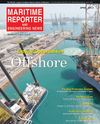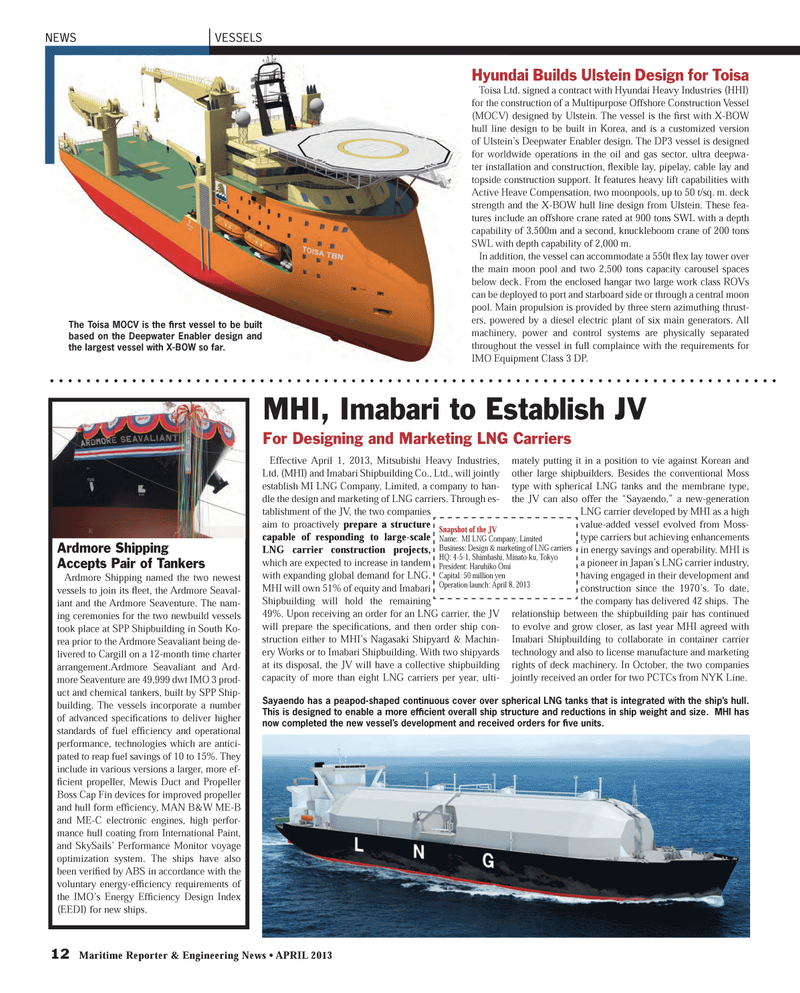
Page 12: of Maritime Reporter Magazine (April 2013)
Offshore Energy Edition
Read this page in Pdf, Flash or Html5 edition of April 2013 Maritime Reporter Magazine
12 Maritime Reporter & Engineering News ? APRIL 2013 NEWSVESSELSHyundai Builds Ulstein Design for Toisa Toisa Ltd. signed a contract with Hyundai Heavy Industries (HHI) for the construction of a Multipurpose Offshore Construction Vessel (MOCV) designed by Ulstein. The vessel is the Þ rst with X-BOW hull line design to be built in Korea, and is a customized version of Ulstein?s Deepwater Enabler design. The DP3 vessel is designed for worldwide operations in the oil and gas sector, ultra deepwa- ter installation and construction, ß exible lay, pipelay, cable lay and topside construction support. It features heavy lift capabilities with Active Heave Compensation, two moonpools, up to 50 t/sq. m. deck strength and the X-BOW hull line design from Ulstein. These fea- tures include an offshore crane rated at 900 tons SWL with a depth capability of 3,500m and a second, knuckleboom crane of 200 tons SWL with depth capability of 2,000 m. In addition, the vessel can accommodate a 550t ß ex lay tower over the main moon pool and two 2,500 tons capacity carousel spaces below deck. From the enclosed hangar two large work class ROVs can be deployed to port and starboard side or through a central moon pool. Main propulsion is provided by three stern azimuthing thrust-ers, powered by a diesel electric plant of six main generators. All machinery, power and control systems are physically separated throughout the vessel in full complaince with the requirements for IMO Equipment Class 3 DP. Ardmore Shipping Accepts Pair of Tankers Ardmore Shipping named the two newest vessels to join its ß eet, the Ardmore Seaval- iant and the Ardmore Seaventure. The nam- ing ceremonies for the two newbuild vessels took place at SPP Shipbuilding in South Ko- rea prior to the Ardmore Seavaliant being de- livered to Cargill on a 12-month time charter arrangement.Ardmore Seavaliant and Ard- more Seaventure are 49,999 dwt IMO 3 prod-uct and chemical tankers, built by SPP Ship- building. The vessels incorporate a number of advanced speciÞ cations to deliver higher standards of fuel efÞ ciency and operational performance, technologies which are antici-pated to reap fuel savings of 10 to 15%. They include in various versions a larger, more ef- Þ cient propeller, Mewis Duct and Propeller Boss Cap Fin devices for improved propeller and hull form efÞ ciency, MAN B&W ME-B and ME-C electronic engines, high perfor- mance hull coating from International Paint, and SkySails? Performance Monitor voyage optimization system. The ships have also been veriÞ ed by ABS in accordance with the voluntary energy-ef Þ ciency requirements of the IMO?s Energy Ef Þ ciency Design Index (EEDI) for new ships.MHI, Imabari to Establish JV For Designing and Marketing LNG CarriersEffective April 1, 2013, Mitsubishi Heavy Industries, Ltd. (MHI) and Imabari Shipbuilding Co., Ltd., will jointly establish MI LNG Company, Limited, a company to han- dle the design and marketing of LNG carriers. Through es- tablishment of the JV, the two companies aim to proactively prepare a structure capable of responding to large-scale LNG carrier construction projects, which are expected to increase in tandem with expanding global demand for LNG. MHI will own 51% of equity and Imabari Shipbuilding will hold the remaining 49%. Upon receiving an order for an LNG carrier, the JV will prepare the speciÞ cations, and then order ship con- struction either to MHI?s Nagasaki Shipyard & Machin- ery Works or to Imabari Shipbuilding. With two shipyards at its disposal, the JV will have a collective shipbuilding capacity of more than eight LNG carriers per year, ulti- mately putting it in a position to vie against Korean and other large shipbuilders. Besides the conventional Moss type with spherical LNG tanks and the membrane type, the JV can also offer the ?Sayaendo,? a new-generation LNG carrier developed by MHI as a high value-added vessel evolved from Moss-type carriers but achieving enhancements in energy savings and operability. MHI is a pioneer in Japan?s LNG carrier industry, having engaged in their development and construction since the 1970?s. To date, the company has delivered 42 ships. The relationship between the shipbuilding pair has continued to evolve and grow closer, as last year MHI agreed with Imabari Shipbuilding to collaborate in container carrier technology and also to license manufacture and marketing rights of deck machinery. In October, the two companies jointly received an order for two PCTCs from NYK Line.The Toisa MOCV is the Þ rst vessel to be built based on the Deepwater Enabler design and the largest vessel with X-BOW so far. Sayaendo has a peapod-shaped continuous cover over spherical LNG tanks that is integrated with the shipÕs hull. This is designed to enable a more efÞ cient overall ship structure and reductions in ship weight and size. MHI has now completed the new vesselÕs development and received orders for Þ ve units. Snapshot of the JVName: MI LNG Company, Limited Business: Design & marketing of LNG carriersHQ: 4-5-1, Shimbashi, Minato-ku, Tokyo President: Haruhiko OmiCapital: 50 million yenOperation launch: April 8, 2013 MR #4 (10-17).indd 12MR #4 (10-17).indd 124/4/2013 5:08:14 PM4/4/2013 5:08:14 PM

 11
11

 13
13
